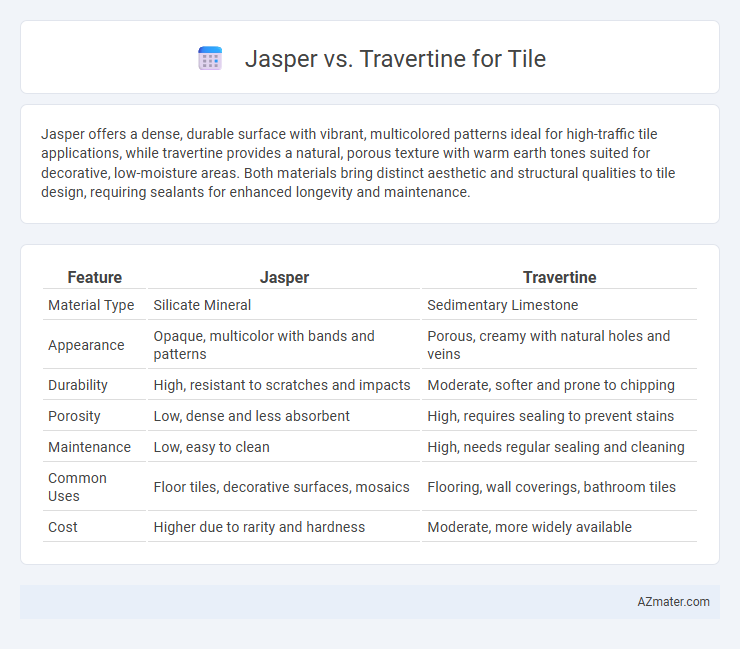Jasper offers a dense, durable surface with vibrant, multicolored patterns ideal for high-traffic tile applications, while travertine provides a natural, porous texture with warm earth tones suited for decorative, low-moisture areas. Both materials bring distinct aesthetic and structural qualities to tile design, requiring sealants for enhanced longevity and maintenance.
Table of Comparison
| Feature | Jasper | Travertine |
|---|---|---|
| Material Type | Silicate Mineral | Sedimentary Limestone |
| Appearance | Opaque, multicolor with bands and patterns | Porous, creamy with natural holes and veins |
| Durability | High, resistant to scratches and impacts | Moderate, softer and prone to chipping |
| Porosity | Low, dense and less absorbent | High, requires sealing to prevent stains |
| Maintenance | Low, easy to clean | High, needs regular sealing and cleaning |
| Common Uses | Floor tiles, decorative surfaces, mosaics | Flooring, wall coverings, bathroom tiles |
| Cost | Higher due to rarity and hardness | Moderate, more widely available |
Introduction: Jasper vs. Travertine Tile
Jasper and travertine are distinct natural stones commonly used for tile flooring and wall applications. Jasper, a dense and durable quartz-based gemstone, offers vibrant patterns and a broad color palette ideal for decorative accents, while travertine is a sedimentary limestone prized for its porous texture and earthy tones that lend a rustic yet elegant appeal. Selecting between jasper and travertine tiles depends on desired aesthetics, durability requirements, and maintenance preferences in interior design projects.
Key Differences Between Jasper and Travertine
Jasper is an opaque, fine-grained variety of chalcedony primarily composed of silicon dioxide, known for its vibrant colors and intricate patterns, making it a popular choice for decorative tile applications. Travertine, a form of limestone deposited by mineral springs, features a porous texture with natural pits and troughs, offering a rustic and earthy aesthetic suitable for flooring and wall tiles. Key differences include jasper's hardness and vibrant coloration versus travertine's softer, more porous surface and natural earth tones, affecting durability, maintenance, and style preferences in tile use.
Appearance and Color Variations
Jasper tiles exhibit rich, deep hues with intricate patterns that often include reds, browns, and yellows, creating a warm and vibrant aesthetic. Travertine tiles are characterized by their natural, earthy tones such as beige, cream, and light brown, featuring distinctive porous textures and linear veining. The color variations in Jasper are typically more intense and varied, while Travertine offers a softer, more uniform appearance with subtle tonal shifts.
Durability and Hardness Comparison
Jasper exhibits higher hardness on the Mohs scale, typically around 6.5 to 7, indicating superior resistance to scratches and wear compared to travertine, which ranks between 3 and 4. Travertine's porous nature makes it more susceptible to abrasion, staining, and chipping, reducing its long-term durability for high-traffic areas. Jasper's dense, non-porous composition enhances its durability, making it ideal for tile applications requiring robust surface integrity and low maintenance.
Maintenance and Cleaning Requirements
Jasper tiles require minimal maintenance with regular sweeping and occasional mopping using a pH-neutral cleaner to prevent surface damage, while they resist stains and scratches effectively. Travertine tiles demand more diligent care, needing sealed surfaces to protect against moisture and stains, along with gentle cleaning using specialized stone cleaners to maintain their natural beauty. Both materials benefit from avoiding harsh chemicals and abrasive tools to preserve their finish over time.
Cost Analysis: Jasper vs. Travertine
Jasper tiles typically cost between $8 to $15 per square foot, making them a more budget-friendly option compared to Travertine, which ranges from $15 to $30 per square foot due to its natural stone composition and extraction process. Installation expenses for both materials vary but tend to be higher for Travertine because of its weight and the need for specialized cutting tools. Maintenance costs for Jasper are generally lower since it is less porous and more resistant to stains, while Travertine requires regular sealing and care to prevent damage and preserve its appearance.
Installation Considerations
Jasper tiles require professional installation due to their hardness and dense composition, which demands specialized diamond-tipped cutting tools and careful handling to avoid chipping. Travertine tiles, being softer and more porous, need sealing before and after installation to prevent staining and water absorption, and they are easier to cut with standard tile saws. Both materials benefit from a skilled installer who understands their unique requirements to ensure durability and aesthetic appeal in the finished flooring or wall surface.
Best Applications for Jasper Tiles
Jasper tiles are highly durable and resistant to wear, making them ideal for high-traffic indoor spaces such as kitchens, bathrooms, and living rooms where both aesthetic appeal and functionality are essential. Their rich, earthy tones and unique patterns enhance rustic, natural, and contemporary design styles, perfectly complementing granite countertops and wooden cabinetry. Unlike travertine, jasper requires less maintenance due to its dense composition, making it a preferred choice for flooring and wall cladding in commercial and residential settings prone to moisture and stains.
Ideal Uses for Travertine Tiles
Travertine tiles are ideal for indoor flooring, bathroom walls, and shower areas due to their natural porous texture and elegant appearance. They provide excellent slip resistance while maintaining durability, making them suitable for both residential and commercial applications. Their warm, earthy tones blend seamlessly with Mediterranean and rustic interior designs, enhancing spaces with a timeless aesthetic.
Which Tile Is Right for Your Project?
Jasper tiles offer rich, earthy colors with natural veining, making them ideal for adding warmth and character to interior spaces such as kitchens and bathrooms. Travertine tiles, known for their porous texture and lighter, neutral tones, provide a classic and elegant look suitable for flooring and outdoor patios, but require sealing to prevent staining. Choosing between jasper and travertine depends on your project's aesthetic goals, maintenance preferences, and desired durability in high-traffic or moisture-prone areas.

Infographic: Jasper vs Travertine for Tile
 azmater.com
azmater.com